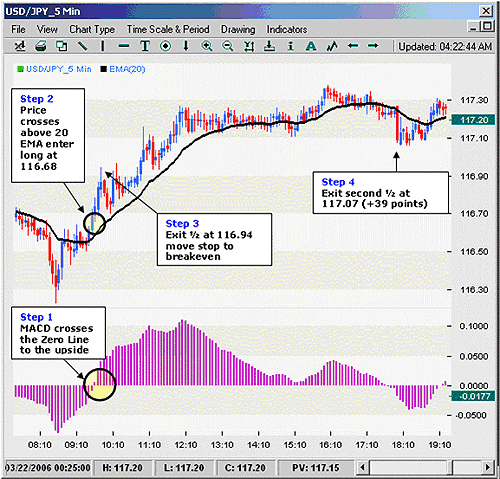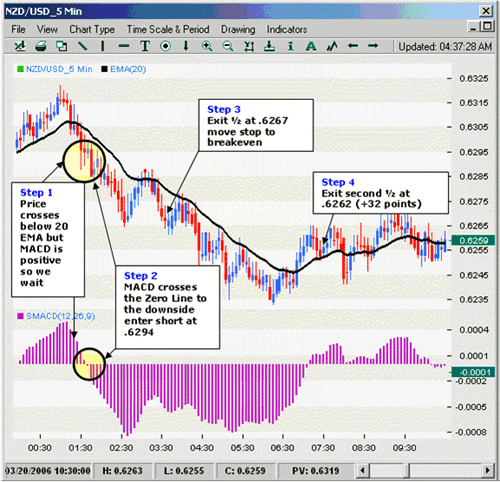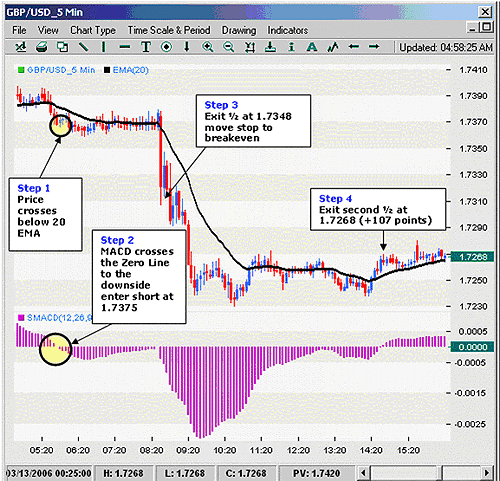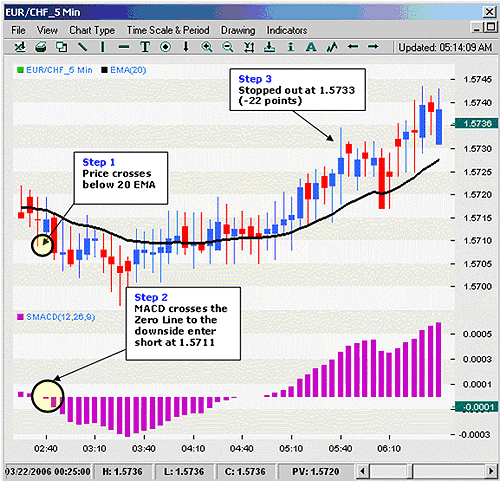Some traders are extremely patient and love to wait for the perfectsetup while others are extremely impatient and need to see a movehappen quickly or they'll abandon their positions. These impatienttraders make perfect momentum tradersbecause they wait for the market to have enough strength to push acurrency in the desired direction and piggyback on the momentum in thehope of an extension move. However, once the move shows signs of losingstrength, an impatient momentum trader will also be the first to jumpship. Therefore, a true momentum strategy needs to have solid exitrules to protect profits while still being able to ride as much of theextension move as possible.
In this article, we'll take a look at strategy that does just that: the Five-Minute Momo Trade.
What's a Momo?
The Five Minute Momo Trade looks fora momentum or "momo" burst on very short-term (five-minute) charts.First, traders lay on two indicators, the first of which is the20-period exponential moving average (EMA). The EMA is chosen over the simple moving average because it places higher weight on recent movements, which is needed for fast momentum trades. The moving average is used to help determine the trend. The second indicator to use is the moving average convergence divergence(MACD) histogram, which helps us gauge momentum. The settings for theMACD histogram is the default, which is first EMA = 12, second EMA =26, signal EMA = 9, all using the close price. (For more insight, read A Primer On The MACD.)
Thisstrategy waits for a reversal trade but only takes advantage of it whenmomentum supports the reversal move enough to create a larger extensionburst. The position is exited in two separate segments; the first halfhelps us lock in gains and ensures that we never turn a winner into aloser. The second half lets us attempt to catch what could become avery large move with no risk because the stop has already been moved tobreakeven.
Rules for a Long Trade
- Look for currency pair trading below the 20-period EMA and MACD to be negative.
- Waitfor price to cross above the 20-period EMA, then make sure that MACD iseither in the process of crossing from negative to positive or hascrossed into positive territory no longer than five bars ago.
- Go long 10 pips above the 20-period EMA.
- Foran aggressive trade, place a stop at the swing low on the five-minutechart. For a conservative trade, place a stop 20 pips below the20-period EMA.
- Sell half of the position at entry plus the amount risked; move the stop on the second half to breakeven.
- Trail the stop by breakeven or the 20-period EMA minus 15 pips, whichever is higher.
Rules for a Short Trade
- Look for the currency pair to be trading above the 20-period EMA and MACD to be positive.
- Waitfor the price to cross below the 20-period EMA; make sure that MACD iseither in the process of crossing from positive to negative or crossedinto negative territory no longer than five bars ago.
- Go short 10 pips below the 20-period EMA.
- Foran aggressive trade, place stop at the swing high on a five-minutechart. For a conservative trade, place the stop 20 pips above 20-periodEMA
- Buy back half of the position at entry minus the amount risked and move the stop on the second half to breakeven.
- Trail stop by lower of breakeven or 20-period EMA plus 15 pips
Long Trades
 | | Figure 1: Five-Minute Momo Trade, EUR/USD | | Source: FXtrek Intellichart |
Our first example in Figure 1 is the EUR/USDon March 16, 2006, when we see the price move above the 20-period EMAas the MACD histogram crosses above the zero line. Although there werea few instances of the price attempting to move above the 20-period EMAbetween 1:30 and 2:00 EST, a trade was not triggered at that timebecause the MACD histogram was below the zero line.
We waitedfor the MACD histogram to cross the zero line and when it did, thetrade was triggered at 1.2044. We enter at 1.2046 + 10 pips = 1.2056with a stop at 1.2046 - 20 pips = 1.2026. Our first target was 1.2056 +30 pips = 1.2084. It was triggered approximately two and a half hourslater. We exit half of the position and trail the remaining half by the20-period EMA minus 15 pips. The second half is eventually closed at1.2157 at 21:35 EST for a total profit on the trade of 65.5 pips.
 | | Figure 2: Five-Minute Momo Trade, USD/JPY | | Source: FXtrek Intellichart |
The next example, shown in Figure 2, is USD/JPYon March 21, 2006, when we see the price move above the 20-period EMA.Like in the previous EUR/USD example, there were also a few instancesin which the price crossed above the 20-period EMA right before ourentry point, but we did not take the trade because the MACD histogramwas below the zero line.
The MACD turned first, so we waitedfor the price to cross the EMA by 10 pips and when it did, we enteredthe trade at 116.67 (EMA was at 116.57).
The math is a bitmore complicated on this one. The stop is at the 20-EMA minus 20 pipsor 116.57 - 20 pips = 116.37. The first target is entry plus the amountrisked, or 116.67 + (116.67-116.37) = 116.97. It gets triggered fiveminutes later. We exit half of the position and trail the remaininghalf by the 20-period EMA minus 15 pips. The second half is eventuallyclosed at 117.07 at 18:00 EST for a total average profit on the tradeof 35 pips. Although the profit was not as attractive as the firsttrade, the chart shows a clean and smooth move that indicates thatprice action conformed well to our rules.
Short Trades
On the short side, our firstexample is the NZD/USD on March 20, 2006 (Figure 3). We see the pricecross below the 20-period EMA, but the MACD histogram is stillpositive, so we wait for it to cross below the zero line 25 minuteslater. Our trade is then triggered at 0.6294. Like the earlier USD/JPYexample, the math is a bit messy on this one because the cross of themoving average did not occur at the same time as when MACD moved belowthe zero line like it did in our first EUR/USD example. As a result, weenter at 0.6294.
Our stop is the 20-EMA plus 20 pips. At thetime, the 20-EMA was at 0.6301, so that puts our entry at 0.6291 andour stop at 0.6301 + 20pips = 0.6321. Our first target is the entryprice minus the amount risked or 0.6291 - (0.6321-0.6291) = 0.6261. Thetarget is hit two hours later and the stop on the second half is movedto breakeven. We then proceed to trail the second half of the positionby the 20-period EMA plus 15 pips. The second half is then closed at0.6262 at 7:10 EST for a total profit on the trade of 29.5 pips.
 | | Figure 3: Five-Minute Momo Trade, NZD/USD | | Source: FXtrek Intellichart |
The example in Figure 4 is based on an opportunity that developed on March 10, 2006, in the GBP/USD.In the chart below, the price crosses below the 20-period EMA and wewait for 10 minutes for the MACD histogram to move into negativeterritory, thereby triggering our entry order at 1.7375. Based on therules above, as soon as the trade is triggered, we put our stop at the20-EMA plus 20 pips or 1.7385 + 20 = 1.7405. Our first target is theentry price minus the amount risked, or 1.7375 - (1.7405 - 1.7375) =1.7345. It gets triggered shortly thereafter. We then proceed to trailthe second half of the position by the 20-period EMA plus 15 pips. Thesecond half of the position is eventually closed at 1.7268 at 14:35 ESTfor a total profit on the trade of 68.5 pips. Coincidently enough, thetrade was also closed at the exact moment when the MACD histogramflipped into positive territory.
 | | Figure 4: Five-Minute Momo Trade, GBP/USD | | Source: FXtrek Intellichart |
Momo Trade Failure
As you can see, theFive Minute Momo Trade is an extremely powerful strategy to capturemomentum-based reversal moves. However, it does not always work and itis important to explore an example of where it fails and to understandwhy this happens.
 | | Figure 5: Five-Minute Momo Trade, EUR/CHF | | Source: FXtrek Intellichart |
The final example of the Five Minute Momo Trade is EUR/CHF on March21, 2006. In Figure 5, the price crosses below the 20-period EMA and wewait for 20 minutes for the MACD histogram to move into negativeterritory, putting our entry order at 1.5711. We place our stop at the20-EMA plus 20 pips or 1.5721 + 20 = 1.5741. Our first target is theentry price minus the amount risked or 1.5711 - (1.5741-1.5711) =1.5681. The price trades down to a low of 1.5696, which is not lowenough to reach our trigger. It then proceeds to reverse course,eventually hitting our stop, causing a total trade loss of 30 pips.
Whentrading the Five Minute Momo strategy the most important thing to bewary of is trading ranges that are too tight or too wide. In quiettrading hours where the price simply fluctuates around the 20-EMA, theMACD histogram may flip back and forth causing many false signals.Alternatively, if this strategy is implemented in a currency paid witha trading range that is too wide, the stop might be hit before thetarget is triggered.
Conclusion
TheFive-Minute Momo Trade allows traders to profit on short bursts ofmomentum, while also providing the solid exit rules required to protectprofits.
by Kathy Lien and Boris Schlossberg, (Contact Author | Biography)
Boris Schlossberg runs BKTraderFX,a forex advisory service and is the senior currency strategist at ForexCapital Markets in New York, one of the largest retail forex marketmakers in the world. He is a frequent commentator for Bloomberg,Reuters, CNBC and Dow Jones CBS Marketwatch. His book, "Millionaire Traders" (John Wiley and Sons) is available on Amazon.com, where he also hosts a blog on all things trading.
Kathy Lien is an internationally published author and the director of currency research at GFT. Her trading books include: "Day Trading the Currency Market: Technical and Fundamental Strategies to Profit form Market Swings" (2005), "High Probability Trading Setups for the Currency Market" E-Book (2006) and "Millionaire Traders: How Everyday People Are Beating Wall Street at Its Own Game" (2007). Lien also runs an FX Signal Service, BKForex Advisor, with Boris Schlossberg - one of the few investment advisory letters focusing strictly on the 2 trillion/day FX market. |






